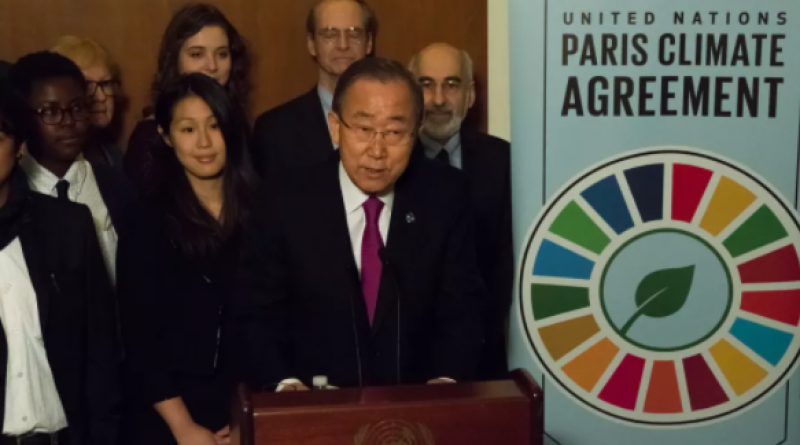What is the Paris Agreement?

In 2015, representatives from 196 nations and territories gathered in Paris to create a landmark plan to mitigate climate change. Is it enough?
In 2015, representatives from 196 nations and territories gathered, as they have been doing every year since 1995, for the United Nations Framework Convention on Climate Change (UNFCCC). During the convention, held in Paris that year, countries and territories (or "parties") agreed to an international plan to address climate change, known as the Paris Agreement.
The parties agreed to three objectives, according to the UNFCCC: limit the average global temperature increase to well below 2 degrees Celsius (3.6 degrees Fahrenheit) above pre-industrial levels, preferably below 1.5 C (2.7 F); build resilience to climate change impacts; and allocate money to these objectives. Each party created its own nationally determined contributions (NDCs) to these goals. Beginning in 2023, the parties will meet every five years to take stock of their progress and plan to ratchet up their NDCs.
The agreement follows several previous attempts at global climate action. For example, the 1997 Kyoto Protocol required 37 industrialized countries to cut their emissions by an average of 5% below 1990 levels. Unlike previous efforts, the Paris Agreement does not mandate different levels of action from countries based on their levels of development, and it does not require that all countries reduce their emissions by some standard amount.
"What was unprecedented about the Paris Agreement is that everybody came together and said, 'Even though we bear different responsibility for the climate problem, we all have a common responsibility to deal with it,'" said Maria Ivanova, an international relations and environmental policy scholar at the University of Massachusetts Boston.
All 197 parties in the United Nations Framework Convention on Climate Change have agreed to be part of the Paris Agreement in some way. Typically, parties would sign the agreement, and then each country's governing body, such as parliament, would vote to ratify it, making an official agreement to participate. So far, 189 countries have completed this process; 6 have signed, but not ratified, it; and 2 have ratified it without signing it first.
The United States joined the Paris Agreement after the 2015 convention. However, the U.S. withdrew from the agreement in 2019 under order from then-President Donald Trump, Live Science previously reported. On Joe Biden's first day as president in 2021, he recommitted the United States to the agreement.
The Paris Agreement addresses an urgent problem: It brought every United Nations-recognized country into a mutual effort to address climate change, a problem that requires quick action by the entire world, according to a report by the Intergovernmental Panel on Climate Change (IPCC).
Past agreements suggest that this one should work — the Paris Agreement is not the first time countries around the world have attempted to solve a common issue by setting their own commitments. In fact, there are thousands of similar agreements currently in place to address problems such as wetlands degradation and pollution.
According to Ivanova, who studies the impacts of these agreements, these types of agreements work because they benefit the countries in the long run. For example, when a country meets its wetlands reparation targets under the Ramsar Convention on Wetlands, it is rewarded with improved quality of life, water availability, electricity supply and flood protection. Therefore, countries see these benefits and work harder to meet their targets.
The agreement is also flexible — it does not enforce repercussions for countries that fall short of their targets, which may be why it garnered widespread buy-in and lofty goals from some countries. But the agreement put in place a robust reporting process, so the world will know whether a country has succeeded or failed — a system the architects hope will foster a culture of ambition in which countries ramp up their goals as green technology improves and becomes cheaper, The Politic reported.
Because the Paris Agreement doesn't call for repercussions, it lacks accountability. Many policy experts and climate activists have argued that the Paris Agreement lacks the teeth needed to make sure countries meet their goals and thereby mitigate the worst impacts of climate change, according to a 2017 critical review of the agreement published in the journal Climate Policy.
The Paris Agreement is also not enough to save the world from human-caused climate change. Even if every country followed through on their pledges, the results would not be enough to prevent the warming associated with heavy precipitation, droughts and ecosystem disruption, according to the IPCC. The United Nations published a February 2021 report describing the strength of 75 parties' NDCs in meeting Paris Agreement goals. Countries' commitments are seriously inadequate, the report found. To limit warming to 1.5 C, global emissions would need to be reduced by 45% by 2030, but the report found that the 75 parties committed to cutting emissions by only less than 1% by 2030.
Another downside is that nations will change their priorities over the time span of this inherently long-term agreement. Since the Paris Agreement was enacted in 2016, the United States has already signed on to it, withdrawn from it and recommitted to it. Keeping countries onboard a long-term project and convincing them to make bolder commitments may prove challenging, Ivanova said.
The Paris Agreement is just getting started. It's a long-term strategy for fighting climate change, and countries just recently submitted their commitments, in 2020. Therefore, it's still hard to say whether it is working. Some countries have already made big strides toward mitigating climate change, while others have been slow to start.
For example, China's commitments and policies have earned it a "highly insufficient" rating from Climate Action Tracker, a consortium of scientific organizations that determines whether a country is doing its fair share to address the climate crisis. China has promised to stop its rate of greenhouse gas emissions from increasing by 2030, and the country has invested in green infrastructure. Still, China is highly dependent on fossil fuels and has a robust coal industry. If every other country's NDCs were equivalent to China's, the globe would be on track for 3 to 4 C (5.4 to 7.2 F) of warming by the end of the 21st century.
In contrast, Morocco is punching above its weight. It is one of the few developing countries on track to reduce its emissions by 2030, and according to Climate Action Tracker, if every country's NDCs were equivalent to Morocco's, global warming could be contained to less than 1.5 C this century.
According to a December 2020 report by Climate Action Tracker, the Paris Agreement appears to be inspiring climate action. The amount of warming projected by the end of the century dropped by 0.7 C (1.3 F) in the five years following the Paris Agreement's initiation. And recently, many countries have ramped up their emissions targets, with China's president, Xi Jinping, promising to make the country carbon-neutral by 2060; President Joe Biden promising to make the U.S. carbon-neutral by 2050; and the European Union announcing a climate proposal that includes halting the sale of new gas-powered cars by 2035.
It remains to be seen if these countries will make good on their promises. "It is important to be ambitious and commit to doing something that would address the problem," Ivanova said. "However, if you don't do anything about that ambition, it doesn't matter."
7 September 2021
LIVE SCIENCE




